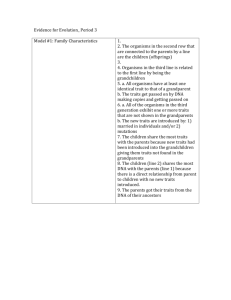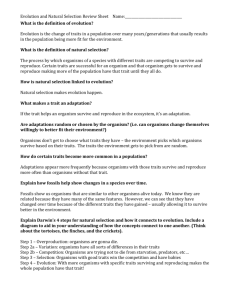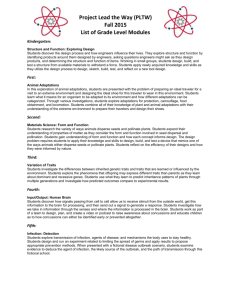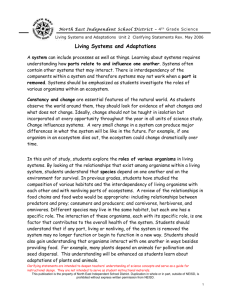Evolution Study Guide
advertisement
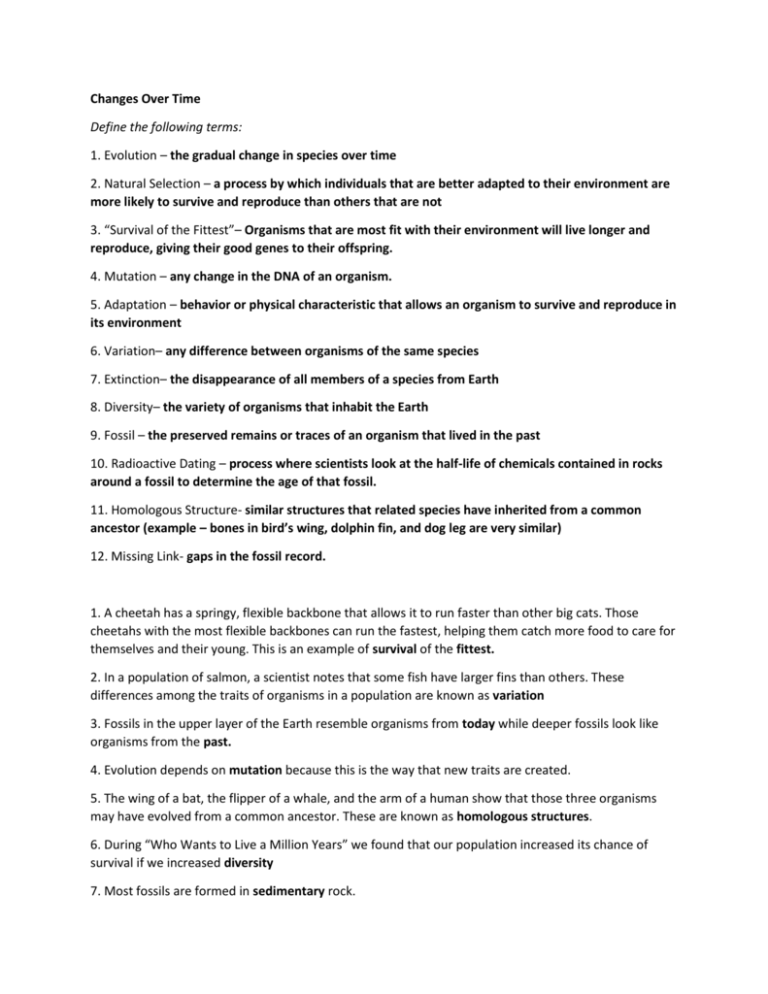
Changes Over Time Define the following terms: 1. Evolution – the gradual change in species over time 2. Natural Selection – a process by which individuals that are better adapted to their environment are more likely to survive and reproduce than others that are not 3. “Survival of the Fittest”– Organisms that are most fit with their environment will live longer and reproduce, giving their good genes to their offspring. 4. Mutation – any change in the DNA of an organism. 5. Adaptation – behavior or physical characteristic that allows an organism to survive and reproduce in its environment 6. Variation– any difference between organisms of the same species 7. Extinction– the disappearance of all members of a species from Earth 8. Diversity– the variety of organisms that inhabit the Earth 9. Fossil – the preserved remains or traces of an organism that lived in the past 10. Radioactive Dating – process where scientists look at the half-life of chemicals contained in rocks around a fossil to determine the age of that fossil. 11. Homologous Structure- similar structures that related species have inherited from a common ancestor (example – bones in bird’s wing, dolphin fin, and dog leg are very similar) 12. Missing Link- gaps in the fossil record. 1. A cheetah has a springy, flexible backbone that allows it to run faster than other big cats. Those cheetahs with the most flexible backbones can run the fastest, helping them catch more food to care for themselves and their young. This is an example of survival of the fittest. 2. In a population of salmon, a scientist notes that some fish have larger fins than others. These differences among the traits of organisms in a population are known as variation 3. Fossils in the upper layer of the Earth resemble organisms from today while deeper fossils look like organisms from the past. 4. Evolution depends on mutation because this is the way that new traits are created. 5. The wing of a bat, the flipper of a whale, and the arm of a human show that those three organisms may have evolved from a common ancestor. These are known as homologous structures. 6. During “Who Wants to Live a Million Years” we found that our population increased its chance of survival if we increased diversity 7. Most fossils are formed in sedimentary rock. Answer the following questions in complete sentences: 8. Why did the population of peppered moths in England change from the light variation to the dark variation after the Industrial Revolution? The white peppered moth was well camouflaged in the white bark of the trees. When industry began, soot polluted the environment and covered the trees, changing their color from white to black. The white moth was no longer camouflaged and the black moth now blended in with the sooty trees. As a result, the white population began to get picked off by birds and the black population became more plentiful as they were now better fit to their surroundings. 9. Modern camels developed their traits of long eyelashes and fat-filled humps through natural selection. What do you think occurs during the process of natural selection with relation to these traits? Natural selection is the process of nature “choosing” which organisms live or die based on their adaptations. Camels developed long eyelashes to block out the sun and prevent sand from entering the eye. Fat filled humps keep them from starving while out in the barren desert. The camels that developed these traits were best suited to live in their hot, dry environment will be “chosen” by nature to live long enough to pass those good traits on to their offspring. 10. Darwin observed and recorded data about several different species of finches. According to Darwin, how did the resources on each island affect the evolution of the finches? Each island had unique food sources and the finches that came to that initially came to each island and survived, had traits that fit with their environment. The longer the finch populations lived on the island, the more reproduction took place, thus passing on good traits to the offspring and making their beak shape more suited for the food source available. 11. Some scientists believe that giant woolly mammoths became extinct when the climate became warmer. Why might this change have led to their extinction? The woolly mammoth evolved to live in cold weather. When the climate changed, the mammoth’s furry coat and thick layer of blubber no longer fit with the environment, causing their population to decline and eventually die out. 12. In our bird beak lab, how did the different tools we used as bird beaks demonstrate adaptation? Each beak was unique and was best suited for specific foods. The tweezers were best for picking up small items like rice; the chopsticks were best for picking up larger items like rubber bands, etc. These adaptations of being able to eat certain foods help the birds live in their environments successfully. 13. Think of an animal that lives in a swamp or marsh. What are three adaptations that this animal has developed? Detail how each one helps it survive in this habitat. Answers will vary Adaptation Benefit Webbed Feet Aid in swimming Fur or feathers that repel water Keeps the animal warm and dry and able to fly (if winged Wide feet Disperses body weight to keep from sinking in muddy surface 14. In the phrase “survival of the fittest” what does it mean to be FIT? Fitness refers to being healthy AND having traits that best fit with the environment. The fittest organisms have the best adaptations and survive the longest, allowing them to mate and pass their good traits on to their offspring. 15. Think of an animal that lives in the Sahara desert. What are three adaptations that this animal has developed? Detail how each one helps it survive in this habitat. Adaptation Benefit Nocturnal Come out at night to avoid heat during the day Dig den in the ground Stay cool in your den during the day. Can also help collect water vapor for drinking water Large eyes Help them to see at night 16. What is the importance of DNA in the human body? How does DNA relate to evolution? DNA carries the instructions needed by the cell to make specific proteins which determine our traits. When our DNA mutates, this accidental change may lead to a trait that produces a positive result, negative result, or NO result. If positive, mutations can often lead to beneficial adaptations which drive the process of evolution. 17. Think of an animal that lives in the snowy tundra. What are three adaptations that this animal has developed? Detail how each one helps it survive in this habitat. Adaptation Benefit Thick layer of blubber Keep animal warm in the cold Travel in tight herds or groups Animals group together to keep heat in Padded feet Stalking prey silently 18. List and define the three types of camouflage and give an example of each. Type of Camouflage Example Concealing Coloration- to blend in with environment A polar bear in a snow drift Disruptive coloration- to distract with contrasting stripes and spots Zebras traveling in a herd Mimicry- to pretend to be something that they’re not A Walking stick on a branch or a viceroy butterfly mimicking a monarch butterfly



